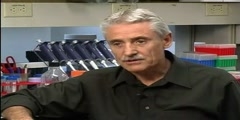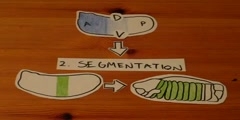Lec 6 - Habitats at Herculaneum and Early Roman Interior Decoration
"Lec 6 - Habitats at Herculaneum and Early Roman Interior Decoration" Roman Architecture (HSAR 252) Professor Kleiner discusses domestic architecture at Herculaneum and the First and Second Styles of Roman wall painting. The lecture begins with an introduction to the history of the city of Herculaneum and what befell some of its inhabitants when they tried to escape obliteration by Vesuvius. She features three houses in Herculaneum, two of which--the Houses of the Mosaic Atrium and the Stags--are among the best examples of a residential style popular in Campania between A.D. 62 and 79. Professor Kleiner then turns to the First or Masonry Style of Roman wall painting, which seeks to replicate the built architecture of Hellenistic kings and other elite patrons by using stucco and paint to imitate a real wall faced with marble. She follows with Second Style Roman wall painting, which uses only paint to open up the wall illusionistically onto vistas and prospects of sacred shrines, city scenes, and landscapes. The lecture concludes with a discussion of the Garden Room from the Villa of Livia at Primaporta, which epitomizes the Second Style by transforming the flat wall into a panoramic window. 00:00 - Chapter 1. Introduction and the History of Herculaneum 13:30 - Chapter 2. Houses at Herculaneum and the Samnite House 20:35 - Chapter 3. Further Developments in Domestic Architecture at Herculaneum: The House of the Mosaic Atrium and the House 37:47 - Chapter 4. First Style Roman Wall Painting 52:02 - Chapter 5. Second Style Roman Wall Painting 01:04:18 - Chapter 6. Second Style Roman Wall Painting and the Family of Augustus Complete course materials are available at the Open Yale Courses website: http://open.yale.edu/courses This course was recorded in Spring 2009.
Video is embedded from external source so embedding is not available.
Video is embedded from external source so download is not available.
Channels: Others
Tags: Lec 6 - Habitats at Herculaneum and Early Roman Interior Decoration
Uploaded by: yalearchitecture ( Send Message ) on 12-09-2012.
Duration: 72m 44s
Here is the next lecture for this course
Lec 1 - Introduction to Roman Architecture
42:31 | 3560 viewsLec 16 - The Roman Way of Life and Death ...
01:16:09 | 4052 viewsLec 18 - Hometown Boy: Honoring an Empero ...
01:12:59 | 3259 viewsLec 3 - Constantine and the Early Church
45:18 | 2526 viewsLec 4 - The Christian Roman Empire
47:56 | 3248 viewsLec 6 -Transformation of the Roman Empire
49:22 | 3494 viewsLec 16 - The Early Middle Ages, 284--1000 ...
44:11 | 2933 viewsLec 19 -The Early Middle Ages, 284--1000: ...
46:15 | 2840 viewsEarly detection: important for servival
00:45 | 6705 viewsOpening a Roman Coffin
00:00 | 6042 viewsDrosophila - Early Development
01:47 | 11870 viewsEarly phase of the small stomach cancer
00:31 | 12189 viewsLec 77 - Early Train Word Problem
07:07 | 3693 viewsLec 20 - Sum of Interior Angles of a Polygon
09:10 | 3279 viewsLec 4 - The Birth of the Early Modern Per ...
10:49 | 2769 viewsNo content is added to this lecture.
This video is a part of a lecture series from of Yale
Lecture list for this course
Lec 1 - Introduction to Roman Architecture
Lec 2 - It Takes a City: The Founding of Rome and the Beginnings of Urbanism in Italy
Lec 3 - Technology and Revolution in Roman Architecture
Lec 4 - Civic Life Interrupted: Nightmare and Destiny on August 24, A.D. 79
Lec 5 - Lifestyles of the Rich and Famous: Houses and Villas at Pompeii
Lec 7 - Gilding the Lily: Painting Palaces and Villas in the First Century A.D.
Lec 8 - Exploring Special Subjects on Pompeian Walls
Lec 9 - From Brick to Marble: Augustus Assembles Rome
Lec 10 - Accessing Afterlife: Tombs of Roman Aristocrats, Freedmen, and Slaves
Lecture 11 - Notorious Nero and His Amazing Architectural Legacy
Lec 12 - The Creation of an Icon: The Colosseum and Contemporary Architecture in Rome
Lec 13 - The Prince and the Palace: Human Made Divine on the Palatine Hill
Lec 14 - The Mother of All Forums: Civic Architecture in Rome under Trajan
Lec 15 - Rome and a Villa: Hadrian's Pantheon and Tivoli Retreat
Lec 16 - The Roman Way of Life and Death at Ostia, the Port of Rome
Lec 18 - Hometown Boy: Honoring an Emperor's Roots in Roman North Africa
Lec 19 - Baroque Extravaganzas: Rock Tombs, Fountains, and Sanctuaries in Jordan, Lebanon, and Libya
















